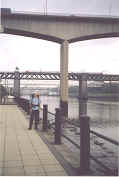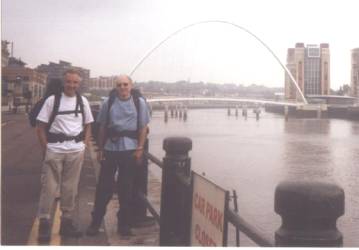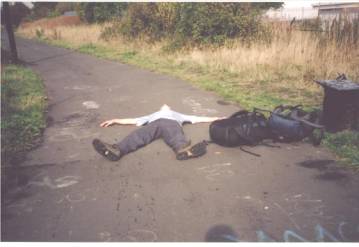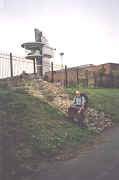
30th September 03
At about 2.30am we are awakened by Reggie
music from an adjoining room, Brian puts his good ear to the pillow and is
oblivious of anything I say, so he obviously cannot hear the music like I can as
I am hard of hearing in both ears but not that deaf that I cannot hear this
dreadful music. It is a radio that is playing as I can hear the intro’s, I am
now tapping my feet to the music, what chance do I stand of getting to sleep. It
eventually goes off after about 2 hours and the silence is deafening.
When we tell the Manager in the morning he
tells us that he had instructed the cleaners to switch off the radio alarms as
some people seem to think that setting the alarm at some unearthly time would be
a good prank. How pathetic.

Fig 6– Approaching the
7 Bridges of
The
miles seemed to fly past as we approached the seven Tyne bridges, first the
‘new’ Redheugh Road Bridge, then the King Edward Railway Bridge, the Queen
Elizabeth II Bridge, the High Level Bridge a road bridge with a railway above,
then the Swing Bridge and the Tyne Bridge, both road bridges and finally the
dramatic Gateshead Millennium Bridge, a pedestrian bridge which we reached by
11.30am. As the Millennium Bridge was opening at 12.05pm we walked over it and
marvelled at the very modern design and the engineering expertise that had gone into the
construction before returning to the Newcastle side to watch it open. The thing
that strikes me every time I see the bridge is the shear simplicity and
functionality of the design, absolute brilliance. The pedestrian walkway, which
is all the bridge is, comprises a 3 meter wide path, curved in 2 planes giving a
very small incline up to the centre, this gives the bridge the ability to allow
river traffic through when the bridge is rotated about 30 degrees, on horizontal
bearings each side.

Whereas
the Tyne Bridge has always been the symbol of Tyneside to my generation, I think
that the younger generation will consider the Millennium Bridge as being their
symbol of Tyneside, and rightly so. It does appear an anomaly that it is called
the Gateshead Millennium Bridge whereas it spans between Gateshead and
Newcastle, maybe Gateshead Council put more money into the project.

Figure
8 – Only 1 mile to go, but that is how I
felt.

Fig 9 – The end of the Roman Wall, but what is that in the background?
Brian kept saying throughout the walk that we should stop when our cap floats. Another 15 minutes brings us to a traffic roundabout with a sign indicating that Segerdunum, which is the end of the walk, is back where we have come from, after some *!$%* and “*#~*, we follow the road back and arrive at that modern observation tower called Segerdunum. After walking 84 miles seeing the remains of Milecastles and Turrets with pictures depicting what these places would have looked like, wouldn’t it have been a marvellous opportunity to build these at Segerdunum instead of an ultra modern observation tower. It’s built now so we go in and leave our haversacks at reception, we are direct to the 3rd floor where the café located and take the lift, but no, the lift numbers are not in Roman numerals and arriving at the counter, no one in sight, shout shop, whereupon an assistant says sorry we have just closed. Can you believe it, I say we have walked 84 miles and you cannot even offer us a cup of tea, she relents and gives us complimentary teas, she is not to blame as the shop closes at 2.00pm, do the Romans have siesta at 2.00pm? we are amazed. We sat in the observation tower and reflected on our achievement. Our triumph has been overcoming the challenge of the physical effort against the elements, our bodies reacted early on in the walk, in various ways, but seemed to disappear as the walk progressed, in fact I don’t recollect much talk of tiredness on the final day. Brian again reminded me that I was doing this for pleasure and at the end I could for the first time see some pleasure and a great sense of achievement.
After taking the obligatory photographs we
boarded the Metro for Newcastle, Brian was getting the train for York and then
Harrogate and I was getting the train to Carlisle and then Penrith. My journey
was through much of the country that we had walked and many parts were
recognisable. The journey from Newcastle to Carlisle took 1½ hours by train,
this brings into perspective the actual distance walked, having taken 5 days for
the same journey.
Brian and I went our separate ways at
Newcastle Central Station, with the thought that we may do the Cleveland Way
next year (109 miles), but that is another day and another year.
p.s. My first roll of film did not
develop.